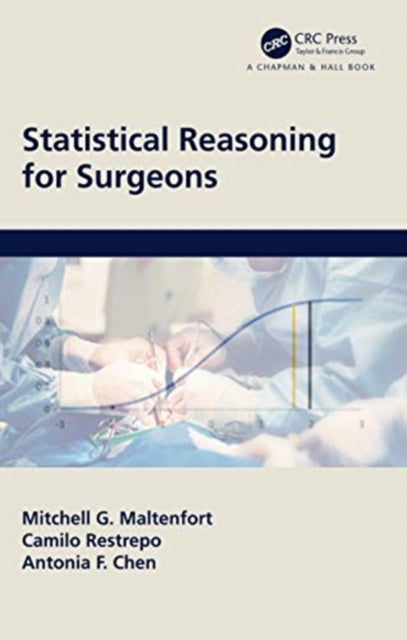Mitchell G. Maltenfort,CamiloRestrepo,Antonia F. Chen
Statistical Reasoning for Surgeons
Statistical Reasoning for Surgeons
YOU SAVE £2.50
- Condition: Brand new
- UK Delivery times: Usually arrives within 2 - 3 working days
- UK Shipping: Fee starts at £2.39. Subject to product weight & dimension
Bulk ordering. Want 15 or more copies? Get a personalised quote and bigger discounts. Learn more about bulk orders.
Couldn't load pickup availability
- More about Statistical Reasoning for Surgeons
Statistics play a crucial role in surgical practice by helping surgeons make informed decisions, optimize outcomes, and improve patient care. They provide valuable insights into surgical risks, complications, and outcomes, allowing surgeons to compare different treatment options and choose the most effective one.
Format: Paperback / softback
Length: 14 pages
Publication date: 29 December 2020
Publisher: Taylor & Francis Ltd
Statistics plays a crucial role in surgical practice, providing valuable insights and decision-making tools that can improve patient outcomes and surgical efficiency. In this article, we will provide a concise and intuitive overview of the role of statistics in surgical practice, using no mathematics but including narrative descriptions of statistical concepts. We will also include topics of specific interest to surgeons, such as risk assessment, surgical planning, and postoperative outcomes. Finally, we will provide real surgical examples to illustrate applications of statistical concepts.
Risk Assessment:
Risk assessment is a critical component of surgical practice, as it helps surgeons identify and quantify the potential risks associated with a surgical procedure. Statistical methods such as probability analysis, decision trees, and Bayesian inference are used to assess these risks. For example, a surgeon may use probability analysis to calculate the likelihood of a surgical complication occurring, such as infection or bleeding. This information can help the surgeon make informed decisions about the surgical approach, such as whether to use a certain surgical instrument or technique or to increase the level of monitoring during the procedure.
Surgical Planning:
Surgical planning is another area where statistics plays a vital role. Statistical methods such as linear programming, optimization, and simulation are used to plan surgical procedures. For example, a surgeon may use linear programming to optimize the surgical schedule, ensuring that all patients receive the necessary care in a timely manner. This can help reduce waiting times and improve patient satisfaction.
Postoperative Outcomes:
Postoperative outcomes are a critical measure of surgical success, and statistical methods are used to assess these outcomes. For example, a surgeon may use survival analysis to calculate the probability of a patient surviving a surgical procedure. This information can help the surgeon compare the outcomes of different surgical procedures and make informed decisions about which procedures to use in specific patient populations.
Real Surgical Examples:
To illustrate the applications of statistical concepts in surgical practice, we will provide real surgical examples. One example is the use of statistical methods to assess the risk of surgical complications in patients with breast cancer. Breast cancer is a common cancer that affects millions of women worldwide. Surgical treatment is a common approach to treating breast cancer, but it is associated with significant risks, such as infection, bleeding, and nerve damage. Statistical methods such as logistic regression and Cox proportional hazards regression are used to assess the risk of surgical complications in patients with breast cancer. These methods allow surgeons to identify factors that are associated with an increased risk of surgical complications and to make informed decisions about the surgical approach.
Another example is the use of statistical methods to plan surgical procedures in patients with lung cancer. Lung cancer is a common cancer that affects millions of people worldwide. Surgical treatment is a common approach to treating lung cancer, but it is associated with significant risks, such as bleeding and lung damage. Statistical methods such as decision trees and Bayesian inference are used to plan surgical procedures in patients with lung cancer. These methods allow surgeons to identify the optimal surgical approach for each patient, taking into account factors such as the size and location of the tumor, the patient's overall health, and the surgical team's experience.
Conclusion:
Statistics plays a crucial role in surgical practice, providing valuable insights and decision-making tools that can improve patient outcomes and surgical efficiency. In this article, we have provided a concise and intuitive overview of the role of statistics in surgical practice, using no mathematics but including narrative descriptions of statistical concepts. We have also included topics of specific interest to surgeons, such as risk assessment, surgical planning, and postoperative outcomes. Finally, we have provided real surgical examples to illustrate applications of statistical concepts. By understanding and applying statistical methods, surgeons can make informed decisions about surgical procedures and improve patient outcomes.
Weight: 206g
Dimension: 214 x 138 x 14 (mm)
ISBN-13: 9781138091702
This item can be found in:
UK and International shipping information
UK and International shipping information
UK Delivery and returns information:
- Delivery within 2 - 3 days when ordering in the UK.
- Shipping fee for UK customers from £2.39. Fully tracked shipping service available.
- Returns policy: Return within 30 days of receipt for full refund.
International deliveries:
Shulph Ink now ships to Australia, Belgium, Canada, France, Germany, Ireland, Italy, India, Luxembourg Saudi Arabia, Singapore, Spain, Netherlands, New Zealand, United Arab Emirates, United States of America.
- Delivery times: within 5 - 10 days for international orders.
- Shipping fee: charges vary for overseas orders. Only tracked services are available for most international orders. Some countries have untracked shipping options.
- Customs charges: If ordering to addresses outside the United Kingdom, you may or may not incur additional customs and duties fees during local delivery.


